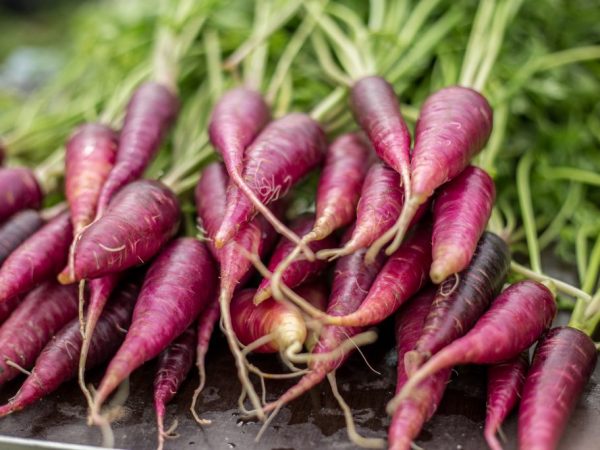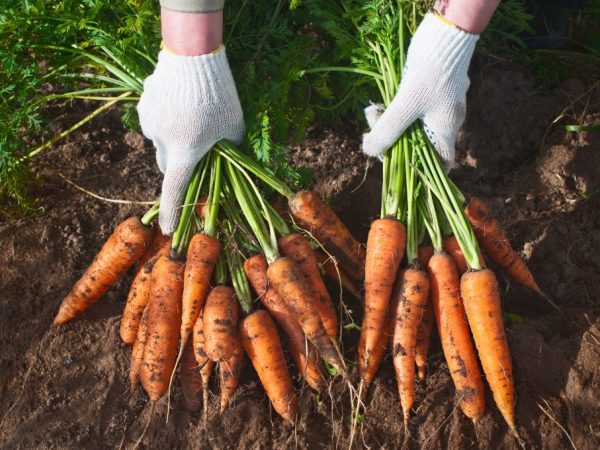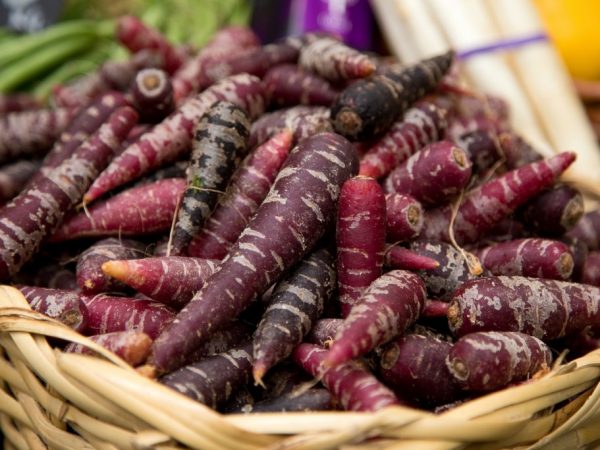Purple carrot
Purple carrots have a complex of useful substances, suitable for inclusion in the diet of every person.
- Characteristic
- Description of the variety
- Types of culture
- Description of the bush
- Description of fruits
- Fruit content
- Growing
- Disembarkation
- Care
- Fertilizer
- Watering
- Fight disease
- Fomoz
- White rot
- Rhizoctonia
- Alternaria
- Bacteriosis
- Cercospora
- Brown spot
- Getting rid of pests
- Carrot fly, flies
- Umbrella moth
- Naked slugs, wireworms
- Carrot aphid
- Exclamation scoop
- Prophylaxis
- Conclusion

Purple carrot
Characteristic
Purple carrots belong to the Umbrella family, subspecies Daucus carota subsp. Sativus. Since the century before last, it has been considered an excellent cure for a number of diseases. The vegetable is characterized by low productivity, good germination, disease and pest resistance.
Purple carrots are widely used in cooking, they are characterized by a useful composition.
Description of the variety
The purple carrot is a biennial herb. When choosing seeds, it is useful to consider the following features:
- storage;
- terms of use;
- marketable condition.
According to the description, varieties of purple carrots are distinguished by high nutritional value and medicinal properties.

Purple carrots are a biennial herb.
Types of culture
Types of purple carrots are grown in different parts of the country. The most popular ones are:
- Purple haze f1. It is an early ripening hybrid of deep purple color, orange inside. The growing season is 70 days. The variety is resistant to diseases. The fruits reach 30 cm in length.
- Dragon. The fruits are sweet, they contain vitamins of group A, beta-carotene. They are bright purple in color, orange inside.
- Rainbow mix. The fruits of the variety are both orange and purple in color, cylindrical in shape, grow up to 18 cm.
- Purple dragon. The variety has a sweet taste. The inner part is orange-yellow, the outer part is violet-red. Fruit length reaches 25 cm.
- Cosmic Purpule. Hybrid variety with a fast ripening rate, bright purple on the outside, orange on the inside. The fruits are sweet, grow up to 20 cm.
Description of the bush
The purple vegetable has a strong root vegetable and feathery leaves.
Description of fruits
The color of the fruit comes in a different purple hue, depending on the species. Their length is 20-30 cm.
Short ones ripen faster than long ones; the depth of the soil affects the development of root crops.
Fruit content
The composition of the vegetable is rich in minerals, 100 g contains:
- magnesium - 38 mg;
- chlorine - 63 mg;
- calcium - 27 mg;
- sodium - 21 mg;
- sulfur - 6 mg;
- potassium - 200 mg;
- phosphorus - 55 mg;
- vanadium - 99 mcg;
- molybdenum - 20 mcg;
- nickel - 6 mcg;
- copper - 80 mcg;
- fluorine - 55 mcg;
- lithium - 6 mcg.
Vitamins in purple carrots:
- A (RE);
- group B;
- FROM;
- beta carotene;
- E, K, PP, N.

The vegetable is rich in minerals
100 g of a vegetable contains 35 kcal. BJU:
- proteins - 1.3 g;
- fats - 0.1 g;
- water - 86.6-88 g;
- carbohydrates - 5.7-6.9 g;
- ash - 1 g;
- dietary fiber - 2.4 g
Growing
Growing carrots is a process that does not require special care for the vegetable.
Disembarkation
Vegetable seeds are characterized by good germination.Sowing in the ground is carried out in early spring. The land is prepared, fertilized.
Good precursors to carrots are potatoes, cucumbers, and onions.
Before planting, the seeds are left in water to germinate. They are planted on the beds at a distance of 1-2 cm. 10-15 cm are left between the rows.
Care
The essence of the care is to loosen the soil, apply fertilizers, dressing, thinning the seedlings. The first thinning is carried out when 1-2 leaves appear on the bush. Large plants are left 2 cm apart
Fertilizer
The vegetable is fed twice a season:
- with the growth of 3-4 leaves, ammonium nitrate is used;
- after the final thinning, superphosphates are used.
Watering
In the summer, seedlings require watering, depending on the condition of the soil. It is carried out in the evening, the water must be absorbed and not leave puddles.

Care consists in loosening the soil, fertilizing, feeding, thinning the seedlings
Fight disease
Carrots protect against the development and spread of diseases and pests.
Fomoz
Phomosis, or gray rot, affects parts of the plant that are above the ground, initially black-brown dents with a white coating appear on the fruit.
The plant cannot be treated, the damaged parts are removed. It will be possible to protect the vegetable if you apply nitrogen fertilizing, spray with 1% Bordeaux liquid.
White rot
The disease leads to damage to the fruit, softness appears, a white bloom, a crust with black dots.
White rot is treated by adding potassium dressings, spraying with copper-containing products, disinfecting the premises where root crops are stored.
Rhizoctonia
Rhizoctonia is a felt rot that affects fruits until dark gray spots appear. Treatment is carried out by spraying with copper oxychloride.
Alternaria
Alternaria is black rot. The plant turns black, the leaves curl. The plantings can be cured with the drug "Rovral".
Bacteriosis
Bacteriosis is characterized by yellow spots on the leaves, gray and white droplets on the petioles, brown stripes on the stems, brown spots, ulcers on the fruits. Not subject to treatment.
Cercosporosis
With the defeat of cercosporosis, light brown spots spread on the foliage, it curls up, a plaque appears. The fruits are deformed. No cure is possible.
Brown spot
Brown spot is a dangerous disease that manifests itself in the form of brown constrictions. The sprouts die, yellow spots appear on the leaves, and brown spots on the stems and petioles.
Getting rid of pests
Under the influence of pests, the plant is capable of completely dying.
Carrot fly
Carrot fly damages root crops. In this case, the leaves become bronze.
Avoiding the spread of carrot flies will work if you get rid of weeds in time. As remedies used "Decis", "Sharpei", ammonia.
The lamb females leave their eggs on the carrot tops. After emergence, the larvae spoil the leaves, the plant dries. Manual collection of eggs, processing with tobacco dust, and soap solution helps to get rid of the pest.
Umbrella moth
A brown moth is dangerous for a vegetable. The affected vegetable turns dark and dries up.
The pest is fought by mechanical collection of caterpillars, digging helps before planting. Spraying with lepidocide, enterobacterin is used.

Under the influence of pests, the plant can completely die.
Naked slugs, wireworms
Naked slugs harm crops, spoil foliage, fruits. A shiny trace of white remains on the vegetable. The sooner you start treatment, the faster the plant will get stronger. Fighting the slug involves treating the plantings with superphosphate or 10% saline.
The wireworm is a yellow worm, the larva of a click beetle. He harms the fruit by eating it. Wireworms get rid of with the help of ammonia, which is included in fertilizers, preparations "Aktara", "Bazudin".
Carrot aphid
Small green insects accumulate on vegetables, foliage deteriorates, fruits are deformed. Soap solution, tobacco, ash helps to fight the pest. As a preventive measure, in hot weather, vegetables are sprayed with warm water.
Exclamation scoop
Caterpillars of butterflies are very harmful to the vegetable. You will be able to fight them with the help of "Decis", "Fury", chamomile infusion.
Prophylaxis
The main preventive measures are considered proper care and the timely start of treatment when any diseases or pests are detected. Not every disease can be treated - it is definitely worth using prevention.
For the prevention of phomosis, phosphorus and potassium dressings are introduced, the tops are removed in time.
Prevention of bacteriosis includes soaking the seeds before planting in the soil, spraying with a homa.
To avoid cercosporosis, seeds are soaked in hot water, young shoots are sprayed with Bordeaux solution.
It will be possible to avoid the appearance of brown spots if you regularly apply loosening between the rows, especially during rains. Treatment with solutions of horsetail, celandine, nettle helps.
Conclusion
Purple carrots are a vegetable rich in vitamins and minerals. Its use has a positive effect on the human body.


